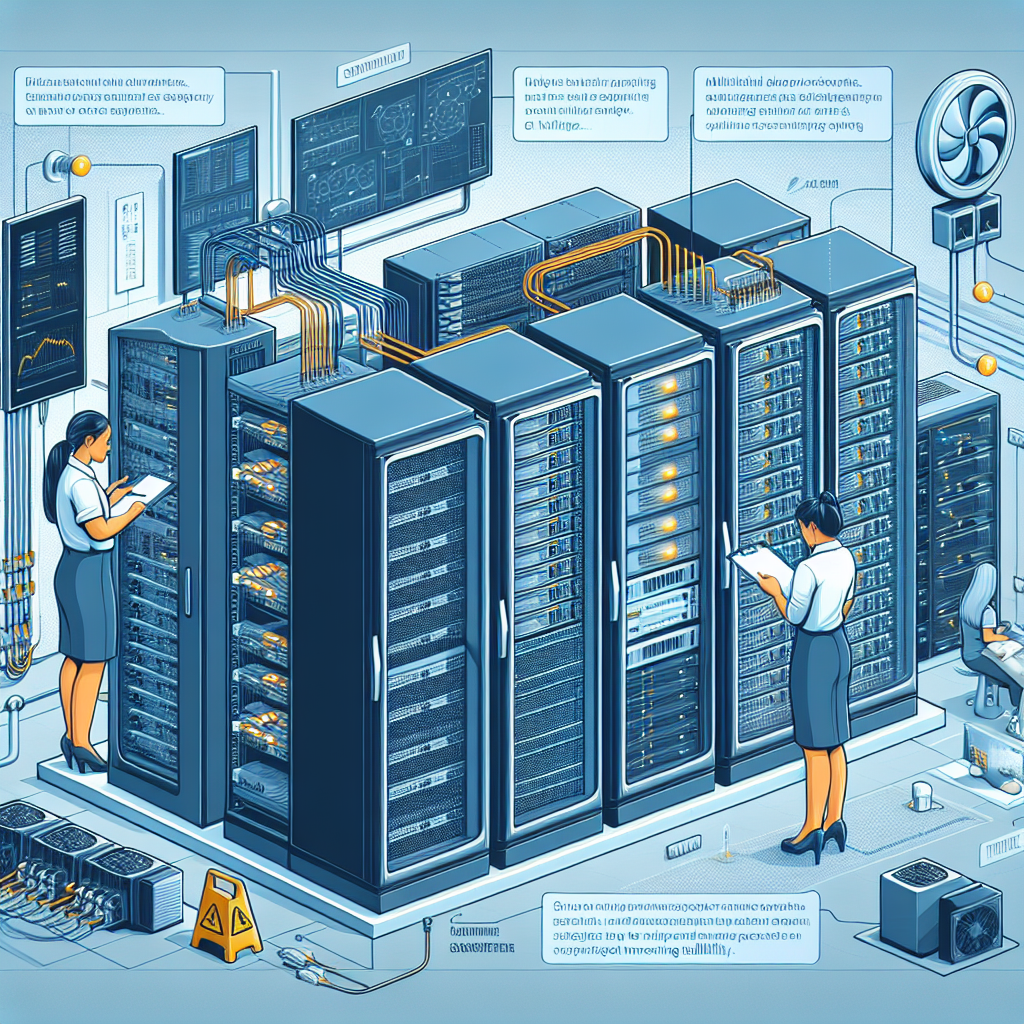Your cart is currently empty!
Tag: Increasing

Increasing Data Center Resilience: Enhancing MTTR Capabilities
In today’s digital age, data centers play a critical role in the operations of businesses and organizations. They store and manage vast amounts of data, ensuring that systems run smoothly and efficiently. However, data centers are not immune to disruptions and downtime, which can have a significant impact on business operations. To mitigate the effects of downtime, organizations are focusing on increasing data center resilience and enhancing Mean Time to Repair (MTTR) capabilities.MTTR is a key metric that measures the average time it takes to repair a system after a failure occurs. The lower the MTTR, the faster a system can be restored to full functionality. By enhancing MTTR capabilities, organizations can minimize the impact of downtime and ensure that critical systems are up and running as quickly as possible.
There are several strategies that organizations can implement to increase data center resilience and improve MTTR capabilities. One of the most effective ways to enhance MTTR capabilities is to implement a comprehensive monitoring and alerting system. By monitoring key performance indicators and receiving real-time alerts, IT teams can proactively identify potential issues before they escalate into major problems.
Another important strategy is to implement a robust disaster recovery plan. A disaster recovery plan outlines the steps that need to be taken in the event of a system failure or outage. By having a well-defined plan in place, organizations can quickly respond to incidents and minimize downtime.
Additionally, organizations can invest in redundant systems and infrastructure to increase resilience and reduce the likelihood of failures. Redundant systems ensure that if one component fails, there is a backup system in place to take over. This redundancy can help to improve system availability and reduce the impact of downtime.
Furthermore, organizations can implement automation and orchestration tools to streamline the repair process and reduce manual intervention. By automating routine tasks and processes, IT teams can respond to incidents more quickly and efficiently, ultimately reducing MTTR.
In conclusion, increasing data center resilience and enhancing MTTR capabilities are crucial for ensuring the smooth operation of critical systems. By implementing monitoring and alerting systems, disaster recovery plans, redundant systems, and automation tools, organizations can minimize downtime and improve system availability. Investing in these strategies will not only help organizations respond to incidents more effectively but also enhance overall operational efficiency and productivity.

Optimizing Data Center Performance: Tips for Increasing Operational Efficiency
Data centers are the backbone of modern businesses, housing the critical infrastructure that supports the digital operations of organizations. As the demands for data processing and storage continue to grow, it is essential for data center operators to optimize their performance to ensure operational efficiency and cost-effectiveness.Here are some tips for increasing operational efficiency in data centers:
1. Implement Energy-efficient Technologies: Energy consumption is one of the major costs associated with running a data center. By implementing energy-efficient technologies such as virtualization, server consolidation, and intelligent cooling systems, data center operators can significantly reduce their energy usage and lower their operating costs.
2. Optimize Cooling Systems: Cooling systems are essential for maintaining the optimal temperature in a data center to prevent equipment overheating. By optimizing the airflow and temperature settings in the data center, operators can reduce energy consumption and improve the overall efficiency of the cooling systems.
3. Use Data Center Infrastructure Management (DCIM) Software: DCIM software provides real-time visibility into the performance of data center infrastructure, allowing operators to monitor and manage various aspects of the data center, including power usage, cooling systems, and equipment utilization. By using DCIM software, data center operators can identify inefficiencies and make informed decisions to optimize performance.
4. Implement Automation: Automation can help streamline data center operations by reducing the need for manual intervention and improving workflow efficiency. By automating routine tasks such as server provisioning, maintenance, and monitoring, data center operators can increase operational efficiency and reduce the risk of human errors.
5. Conduct Regular Maintenance and Upgrades: Regular maintenance and upgrades are essential for ensuring the reliability and performance of data center infrastructure. By conducting routine inspections, equipment maintenance, and upgrades, operators can prolong the lifespan of their equipment and prevent costly downtime due to equipment failures.
6. Monitor and Analyze Performance Metrics: Monitoring and analyzing performance metrics such as power usage, cooling efficiency, and server utilization can provide valuable insights into the overall performance of the data center. By tracking key performance indicators and identifying areas for improvement, operators can optimize their data center performance and achieve greater operational efficiency.
In conclusion, optimizing data center performance is crucial for increasing operational efficiency and reducing costs. By implementing energy-efficient technologies, optimizing cooling systems, using DCIM software, implementing automation, conducting regular maintenance and upgrades, and monitoring performance metrics, data center operators can improve the overall efficiency of their data centers and ensure the smooth operation of their critical infrastructure.

Increasing Data Center Uptime with Effective MTBF Strategies
Data centers are critical components of modern businesses, providing the infrastructure needed to store, manage, and process vast amounts of data. Downtime in a data center can have serious consequences, including lost revenue, reputational damage, and decreased productivity. Therefore, ensuring maximum uptime is essential for businesses that rely on data centers to operate.One effective strategy for increasing data center uptime is to implement Mean Time Between Failures (MTBF) strategies. MTBF is a measure of how reliable a system is and is calculated as the average time between failures. By effectively managing MTBF, data center managers can reduce the likelihood of unplanned downtime and increase the overall reliability of their data center infrastructure.
There are several key strategies that can be used to improve MTBF and increase data center uptime. One important strategy is to regularly monitor and maintain critical components of the data center infrastructure. This includes conducting regular inspections, performing preventative maintenance, and replacing aging equipment before it fails. By proactively managing the health of the data center infrastructure, managers can reduce the risk of unexpected failures and extend the lifespan of their equipment.
Another important strategy for improving MTBF is to implement redundancy in critical systems. Redundancy involves having backup systems in place that can quickly take over in the event of a failure. This can include redundant power supplies, backup cooling systems, and duplicate network connections. By implementing redundancy, data center managers can ensure that the data center can continue to operate smoothly even if one component fails.
In addition to monitoring and maintenance, data center managers can also improve MTBF by investing in high-quality equipment and components. While cost may be a consideration, investing in reliable, high-quality equipment can pay off in the long run by reducing the likelihood of failures and increasing overall uptime. It is also important to work with reputable vendors and manufacturers who stand behind their products and provide reliable support and service.
Overall, implementing effective MTBF strategies is crucial for increasing data center uptime and ensuring the reliability of critical infrastructure. By monitoring and maintaining critical components, implementing redundancy, and investing in high-quality equipment, data center managers can reduce the risk of downtime and ensure that their data center remains operational and reliable. Ultimately, by prioritizing uptime and implementing effective MTBF strategies, businesses can protect their data and ensure that their operations run smoothly and efficiently.

Innovative Technologies for Increasing Data Center Sustainability
Innovative Technologies for Increasing Data Center SustainabilityAs the demand for data storage and processing continues to grow exponentially, data centers are faced with the challenge of increasing their sustainability while maintaining high levels of performance and reliability. Fortunately, advancements in technology are providing data center operators with a range of innovative solutions to help reduce their environmental impact and energy consumption. From cooling systems to power management tools, these technologies are enabling data centers to operate more efficiently and sustainably than ever before.
One of the key areas where data centers can improve their sustainability is in cooling systems. Traditional data center cooling methods, such as air conditioning, can be extremely energy-intensive and contribute to a significant portion of a data center’s overall energy consumption. However, newer technologies, such as liquid cooling systems and hot aisle containment, are helping data centers to reduce their cooling energy requirements and lower their carbon footprint. Liquid cooling systems, for example, use water or other coolants to remove heat from servers, resulting in lower energy consumption and reduced environmental impact.
Another innovative technology that is helping data centers to increase their sustainability is power management tools. These tools allow data center operators to monitor and optimize their energy usage in real-time, enabling them to identify areas where energy is being wasted and make adjustments to improve efficiency. By implementing power management tools, data centers can reduce their energy consumption, lower their operating costs, and decrease their carbon emissions.
In addition to cooling systems and power management tools, data centers are also exploring new technologies such as renewable energy sources and energy storage systems. Renewable energy sources, such as solar and wind power, can help data centers to reduce their reliance on fossil fuels and lower their carbon emissions. Energy storage systems, such as batteries and flywheels, can also help data centers to store excess energy and use it during times of peak demand, further reducing their reliance on conventional power sources.
Overall, innovative technologies are providing data centers with the tools they need to increase their sustainability and reduce their environmental impact. By implementing solutions such as liquid cooling systems, power management tools, renewable energy sources, and energy storage systems, data centers can operate more efficiently and responsibly, while still meeting the growing demands for data storage and processing. As the industry continues to evolve, it is clear that sustainability will be a key focus for data center operators, and innovative technologies will play a crucial role in helping them to achieve their sustainability goals.

Increasing Data Center Resilience through Effective MTTR Management
In today’s digital age, data centers play a crucial role in storing and processing vast amounts of information for businesses and organizations. As such, it is essential to ensure that data centers are resilient and can withstand any disruptions that may occur. One key factor in increasing data center resilience is effectively managing Mean Time to Repair (MTTR) – the average time it takes to repair a system after a failure.There are several strategies that data center managers can employ to improve MTTR management and enhance data center resilience. One of the most important steps is to have a comprehensive and up-to-date inventory of all hardware and software components in the data center. This inventory should include information such as the make and model of each component, its location within the data center, and any relevant maintenance or support contracts.
By having a detailed inventory, data center managers can quickly identify and troubleshoot any issues that arise, reducing the time it takes to repair a system. Additionally, regular maintenance and monitoring of hardware and software components can help prevent failures before they occur, further decreasing MTTR.
Another key strategy for improving MTTR management is to establish clear and efficient communication channels within the data center. This includes ensuring that all staff are trained on how to report and escalate issues, as well as having a designated point of contact for emergency situations. By streamlining communication, data center managers can quickly mobilize resources and address issues as they arise, reducing downtime and improving MTTR.
In addition to these strategies, data center managers can also leverage automation and predictive analytics to help identify and address potential issues before they impact system performance. By using tools such as monitoring software and machine learning algorithms, data center managers can proactively identify patterns and trends that may indicate a potential failure, allowing them to take corrective action before a system goes down.
Overall, effective MTTR management is essential for increasing data center resilience and ensuring that critical systems remain operational in the face of disruptions. By implementing a comprehensive inventory system, establishing clear communication channels, and leveraging automation and predictive analytics, data center managers can reduce downtime, improve system performance, and enhance overall data center resilience.

Strategies for Reducing Data Center MTTR and Increasing Operational Efficiency
When it comes to managing a data center, reducing Mean Time to Repair (MTTR) is crucial for maintaining operational efficiency and minimizing downtime. MTTR measures the average time it takes to repair a system or component after a failure occurs. The longer it takes to repair a system, the more downtime a data center experiences, leading to potential losses in revenue and productivity.To improve MTTR and increase operational efficiency in a data center, it is essential to implement strategies that streamline the repair process and prevent future failures. Here are some effective strategies for reducing MTTR and enhancing operational efficiency in a data center:
1. Implement proactive monitoring and maintenance: Regularly monitoring the performance and health of data center systems can help identify potential issues before they escalate into major failures. Implementing proactive maintenance practices, such as regular system checks and software updates, can prevent unexpected downtime and reduce the need for lengthy repair processes.
2. Implement automation tools: Automation tools can help streamline the repair process by automating routine tasks and alerts. By automating repetitive tasks, data center staff can focus on more critical issues and respond quickly to system failures. Automation tools can also help identify and resolve issues before they impact operations, reducing MTTR and increasing operational efficiency.
3. Implement a comprehensive incident response plan: Having a well-defined incident response plan in place can help data center staff respond quickly and effectively to system failures. The plan should outline the steps to take when a failure occurs, including identifying the root cause, troubleshooting the issue, and implementing a solution. By following a structured incident response plan, data center staff can reduce MTTR and minimize downtime.
4. Implement a robust backup and disaster recovery strategy: Data loss can result in significant downtime and operational disruptions. Implementing a robust backup and disaster recovery strategy can help minimize data loss and reduce MTTR in the event of a system failure. Regularly backing up critical data and implementing disaster recovery solutions can help data center staff quickly restore operations and minimize downtime.
5. Conduct regular training and skills development: Investing in training and skills development for data center staff can help improve their ability to troubleshoot and repair system failures quickly. By providing staff with the necessary skills and knowledge, data center managers can reduce MTTR and increase operational efficiency.
By implementing these strategies, data center managers can reduce Mean Time to Repair (MTTR) and increase operational efficiency in their data centers. Proactive monitoring and maintenance, automation tools, incident response plans, backup and disaster recovery strategies, and regular training and skills development are essential for minimizing downtime and ensuring smooth operations in a data center.

Increasing Data Center Efficiency through MTBF Optimization
Data centers are essential components of modern business operations, providing the infrastructure needed to store and process large amounts of digital data. As the demand for data storage continues to grow, data centers are under increasing pressure to operate efficiently and reliably. One way to improve data center efficiency is through Mean Time Between Failure (MTBF) optimization.MTBF is a measure of the average time between failures in a system. By increasing the MTBF of critical components in a data center, organizations can reduce downtime, improve reliability, and ultimately increase operational efficiency. There are several strategies that can be employed to optimize MTBF in a data center:
1. Regular maintenance and monitoring: Regular maintenance and monitoring of critical components such as servers, storage devices, and networking equipment can help identify potential issues before they lead to failures. By proactively addressing issues, organizations can extend the lifespan of their equipment and reduce the likelihood of unplanned downtime.
2. Redundancy and fault tolerance: Implementing redundancy and fault-tolerant design principles can help mitigate the impact of component failures. By having backup systems in place, organizations can ensure that critical operations can continue even in the event of a failure.
3. Temperature and humidity control: Data centers generate a significant amount of heat, which can impact the performance and lifespan of equipment. By maintaining optimal temperature and humidity levels, organizations can prolong the lifespan of their equipment and improve overall reliability.
4. Power management: Power outages and fluctuations can lead to system failures and data loss. Implementing uninterruptible power supplies (UPS) and backup generators can help ensure that data center operations remain uninterrupted in the event of a power outage.
5. Data center design: The layout and design of a data center can also impact MTBF. By optimizing airflow, minimizing cable clutter, and ensuring proper cooling, organizations can create a more efficient and reliable data center environment.
By implementing these strategies and optimizing MTBF in their data centers, organizations can improve operational efficiency, reduce downtime, and ultimately save costs. As the demand for data storage continues to grow, optimizing MTBF will become increasingly important for organizations looking to stay competitive in the digital age.

Improving Data Center Reliability: Strategies for Increasing MTBF
In today’s digital age, data centers are the backbone of any organization, housing critical information and ensuring the smooth operation of business processes. As such, ensuring the reliability of a data center is essential to prevent costly downtime and potential data loss. One key metric used to measure the reliability of a data center is Mean Time Between Failures (MTBF), which represents the average time between failures of a system.Improving the MTBF of a data center requires a multi-faceted approach that addresses various aspects of the infrastructure and operations. Here are some strategies for increasing MTBF and enhancing the reliability of a data center:
1. Regular maintenance and monitoring: Regular maintenance and monitoring of data center equipment are essential to identify potential issues before they escalate into full-blown failures. Implementing a proactive maintenance schedule and utilizing monitoring tools can help detect early signs of equipment degradation and prevent unexpected downtime.
2. Redundancy and failover systems: Implementing redundancy and failover systems is crucial to ensure continuous operation of critical systems in the event of a failure. This can include redundant power supplies, network connections, and storage systems. By having backup systems in place, organizations can minimize the impact of hardware failures and maintain high availability.
3. Temperature and humidity control: Proper temperature and humidity control are essential for maintaining the optimal operating conditions of data center equipment. Overheating or excessive humidity can lead to equipment failures and downtime. Investing in HVAC systems and monitoring tools can help ensure that the data center environment remains within the recommended range.
4. Regular testing and simulation: Conducting regular testing and simulation exercises can help identify weaknesses in the data center infrastructure and improve overall reliability. By simulating various failure scenarios and testing the failover systems, organizations can better prepare for unexpected events and minimize the impact on operations.
5. Staff training and documentation: Ensuring that data center staff are well-trained and have access to comprehensive documentation is essential for maintaining reliability. Proper training can help prevent human errors and ensure that staff are equipped to respond effectively to emergencies. Additionally, documenting procedures and configurations can help streamline troubleshooting and recovery efforts.
By implementing these strategies and focusing on improving MTBF, organizations can enhance the reliability of their data center infrastructure and minimize the risk of downtime. Investing in proactive maintenance, redundancy systems, temperature control, testing, and staff training can help ensure that data centers operate smoothly and efficiently, supporting the overall success of the organization.

Tips for Increasing Data Center MTBF and Enhancing Data Center Performance
Data centers are the backbone of modern businesses, providing the necessary infrastructure for storing and processing vast amounts of data. However, ensuring the reliability and performance of a data center can be a challenge, as downtime can lead to significant financial losses and damage to a company’s reputation. One key metric for measuring the reliability of a data center is Mean Time Between Failures (MTBF), which represents the average time between equipment failures.To increase the MTBF of a data center and enhance its performance, there are several tips that data center managers can follow:
1. Regular Maintenance: Regular maintenance of data center equipment is crucial for ensuring its reliability and longevity. This includes cleaning, inspecting, and testing all hardware components on a routine basis to identify and address any potential issues before they escalate into major failures.
2. Redundancy: Implementing redundancy in critical systems such as power supplies, cooling systems, and network connections can significantly increase the reliability of a data center. Redundant components can automatically take over in case of a failure, minimizing downtime and ensuring uninterrupted operation.
3. Monitoring and Management: Utilizing advanced monitoring and management tools can help data center managers proactively identify potential issues and take corrective actions before they impact operations. Real-time monitoring of key performance indicators such as temperature, humidity, and power consumption can provide valuable insights into the health of the data center infrastructure.
4. Energy Efficiency: Improving energy efficiency not only reduces operating costs but also enhances the reliability of data center equipment. By optimizing cooling systems, implementing virtualization technologies, and adopting energy-efficient hardware, data center managers can reduce heat generation and extend the lifespan of critical components.
5. Disaster Recovery Planning: Developing a comprehensive disaster recovery plan is essential for ensuring the continuity of operations in the event of a major outage or disaster. Data center managers should regularly test their disaster recovery procedures and update them as needed to address evolving threats and challenges.
6. Training and Education: Investing in training and education for data center staff can help improve the overall performance and reliability of the facility. Well-trained personnel are better equipped to identify and troubleshoot issues, implement best practices, and ensure the proper maintenance of equipment.
By following these tips for increasing MTBF and enhancing data center performance, organizations can minimize downtime, improve operational efficiency, and protect their valuable data assets. Data center managers should continuously evaluate and optimize their infrastructure to meet the evolving demands of the digital age and ensure the reliability and performance of their data center operations.

Maximizing Uptime: Strategies for Increasing Data Center MTBF
In today’s digital age, data centers play a crucial role in storing, processing, and managing vast amounts of information for businesses of all sizes. However, as data center usage continues to grow, the need to maximize uptime has become increasingly important. Downtime can be costly for businesses, resulting in lost revenue, damaged reputation, and decreased productivity. To combat this, data center operators must focus on increasing Mean Time Between Failures (MTBF) to ensure continuous operation and optimal performance.There are several strategies that data center operators can implement to maximize uptime and increase MTBF. One of the most effective ways to achieve this is through regular maintenance and monitoring of critical infrastructure components. By conducting routine inspections and testing of power sources, cooling systems, and network equipment, operators can identify potential issues before they escalate into major failures. Implementing a proactive maintenance schedule can help prevent downtime and extend the lifespan of data center equipment.
Another key strategy for increasing MTBF is implementing redundancy and failover mechanisms. By incorporating backup power sources, cooling systems, and network connections, data center operators can ensure continuous operation in the event of a component failure. Redundancy can help mitigate the impact of hardware failures and natural disasters, minimizing downtime and maintaining critical operations. Additionally, implementing failover mechanisms can automatically redirect traffic and workload to backup systems, ensuring seamless operation during unexpected events.
In addition to maintenance and redundancy, data center operators can also leverage advanced monitoring and analytics tools to optimize performance and predict potential failures. By collecting and analyzing data on equipment performance, operators can identify trends and patterns that may indicate impending failures. Implementing predictive maintenance strategies based on real-time data can help prevent downtime and increase MTBF by addressing issues before they impact operations.
Furthermore, investing in high-quality equipment and infrastructure can contribute to maximizing uptime and increasing MTBF. By selecting reliable and durable components from reputable vendors, data center operators can reduce the risk of hardware failures and ensure consistent performance. Choosing energy-efficient and scalable solutions can also help future-proof data centers, allowing for seamless expansion and upgrades without disrupting operations.
Overall, maximizing uptime and increasing MTBF are essential priorities for data center operators looking to maintain reliable and efficient operations. By implementing proactive maintenance, redundancy, monitoring, and investing in high-quality equipment, operators can minimize downtime, optimize performance, and ensure continuous operation of critical systems. By prioritizing uptime, data center operators can effectively support their business operations and meet the demands of a rapidly evolving digital landscape.
